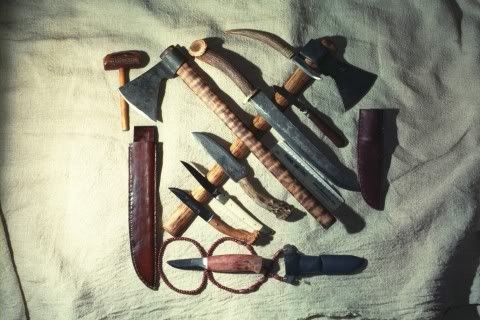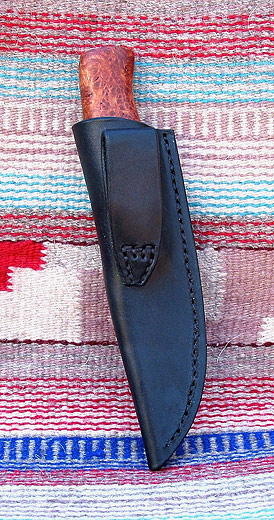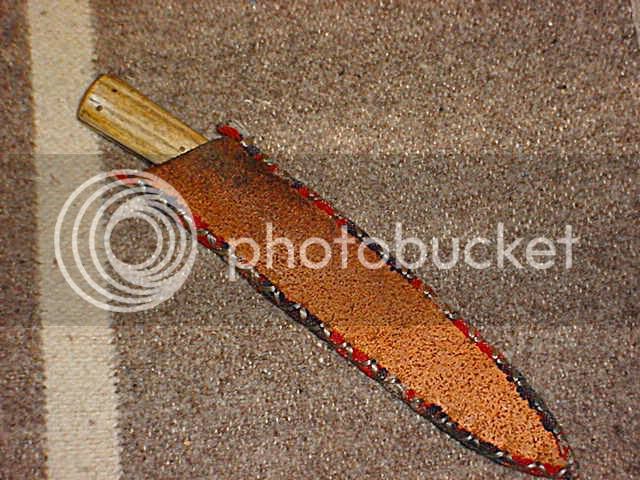Any folks out there know of/seen an authentic 18tyh century knife sheath? I have a butcher knife I need to cover, but I haven't a clue what kind of sheath to make. I toyed with the idea of a "kabar" style sheat, as they sit well on the belt, but I want one that rides more toward the front. I've heard that the earlier sheaths slipped into the belt and tied in place, but I haven't seen any documentation at all concerning sheathing.
-
This community needs YOUR help today. We rely 100% on Supporting Memberships to fund our efforts. With the ever increasing fees of everything, we need help. We need more Supporting Members, today. Please invest back into this community. I will ship a few decals too in addition to all the account perks you get.

Sign up here: https://www.muzzleloadingforum.com/account/upgrades -
Friends, our 2nd Amendment rights are always under attack and the NRA has been a constant for decades in helping fight that fight.
We have partnered with the NRA to offer you a discount on membership and Muzzleloading Forum gets a small percentage too of each membership, so you are supporting both the NRA and us.
Use this link to sign up please; https://membership.nra.org/recruiters/join/XR045103
You are using an out of date browser. It may not display this or other websites correctly.
You should upgrade or use an alternative browser.
You should upgrade or use an alternative browser.
need accurate 18th C. belt knife sheath pattern
- Thread starter bnail
- Start date

Help Support Muzzleloading Forum:
This site may earn a commission from merchant affiliate
links, including eBay, Amazon, and others.
onefeather
45 Cal.
- Joined
- May 13, 2005
- Messages
- 838
- Reaction score
- 0
i wear a eastern beaded sheath and i just slip it in my belt i dont tie it or anything but come hunting season will be the big test but if i have to tie it i will but it hold tight for now but look at this site and the sheaths on ithttp://www.swampfoxknives.com/page_4.html he has good knives and the sheaths seem practical to and you can email him and he is always helpful if you want to know how to build something :m2c:
I took a wild stab at it and made a wet fitted heavy Elk rawhide pocket sheath and let it dry on the knife, then sewed a BT deerhide cover over it with Elk sinew and did some simple "lazy" pony bead strips around the perimiter, it is a snug fit and slipped into my sash but can be tied to the sash with BT wangs if I want to. No documentation but it is similar to several NA sheaths I have seen pics and drawings of, I gave it to a young fella who was trying to make up an ouitfit so I cannot show any pics but I do have one like it somewhere with a coon skin cover and a pic of one with a Beaver tail cover, I will see if I can find some pics of those in the next few days.
Groan ::I took a wild stab at it and made a . . . sheath
I went with simple. The sheaths on either side of this pile are plain and straight forward. The larger is 10 oz pigskin, the smaller 7 oz cow, both vegetable tanned, walnut stained and then rubbed with many coats of beeswax after dry (formed to the knives while wet and allowed to dry with the well waxed knife in place). The pigskin sounds like wood when rapped with a knuckle.

Added 1/4" for a seam all around the blade, grooved the face for the seam and sewed it up with beeswaxed linen. The top is skivved for the blade to enter easy. The belt loop is a personal preference. 1" wide and a seperate strap. Sewed on the back before the front is stitched on. Folded over so the sheath rides lower on the belt. I have no proof that this was ever done, but it carries well and secure with either a wide or narrow belt. One rides a couple inches up the handle (the smaller, skinning knife) and the other ends at the small oval guard (the 10" rifleman's knife - the two knives either side of the striped hawk). Both knives are easy to get at and stay put.
I have photos of a knife and sheath dated to from the early to mid 18th century. It is also illustrated as a line drawing in the "Roger's Rangers Sketchbook". It has an ivory handle carved with figures from the garden of Eden, it has a sheepsfoot style blade. The sheath is embossed leather with a center seam and includes a leather cap to slip over the top of the handle and upper part of the sheath.
To see nearly identical knives go to www.lanouvelle-france.com click on "More French Trade Knives" scroll to "Flemish Type Knives". It includes a couple of early sheaths.
Regards, Dave
To see nearly identical knives go to www.lanouvelle-france.com click on "More French Trade Knives" scroll to "Flemish Type Knives". It includes a couple of early sheaths.
Regards, Dave
Not quite sure what is going on here, Stumpy. Okay, the loop is folded over (as it would have to be to work as a belt loop, I reckon). How is that involved in making the sheath "ride lower"? Got a pic to show me what is happening?The belt loop is .... Folded over so the sheath rides lower on the belt.
Okwaho
I don't have my books right in front of me, but I believe I did make a mistake. The knife was not in Sketchbook '56, I believe it is in "The Long Hunters Sketchbook". My apologies.
I am reading all the time and have a pretty fair personal library so I sometimes get my references mixed up. I do have photos of the knife somewhere in my files. It is a very nice 18th century knife.
Fatdutchman
My apologies to you also. I just realized that you were probably more interested in sheaths used by the white Frontiersmen rather that Native Americans. The knives and sheaths illustrated are trade knives with sheaths made of brain tanned leather with beads and quill work, they are astounding. The book "Bojou NeeGee" was a display of Native American artifacts in the Museum of Man. It includes several excellent pouches, leggins, and an absolutely gorgeous coat from the mid 18th century made of brain tan and painted designs made with fish glue paint
Regards, Dave
I don't have my books right in front of me, but I believe I did make a mistake. The knife was not in Sketchbook '56, I believe it is in "The Long Hunters Sketchbook". My apologies.
I am reading all the time and have a pretty fair personal library so I sometimes get my references mixed up. I do have photos of the knife somewhere in my files. It is a very nice 18th century knife.
Fatdutchman
My apologies to you also. I just realized that you were probably more interested in sheaths used by the white Frontiersmen rather that Native Americans. The knives and sheaths illustrated are trade knives with sheaths made of brain tanned leather with beads and quill work, they are astounding. The book "Bojou NeeGee" was a display of Native American artifacts in the Museum of Man. It includes several excellent pouches, leggins, and an absolutely gorgeous coat from the mid 18th century made of brain tan and painted designs made with fish glue paint
Regards, Dave

This isn't one of mine, but it's basically the same. The strap is a seperate piece of leather. Laid face down on the leather of the sheath back with all but an inch or so over where the opening will be. It's punched with an awl & stitched, then folded down so that the strap is level with the opening or slightly below, and then the lower attachment point is stitched. Sew with the leather damp and the stitching is pulled below the surface as it dries where it is protected from blade & wear.
Then, the sheath is pieced together & the front and back portions are stitched together. For the smaller knives I use a two-piece as shown. The larger ones (having a cross-guard) I use a three-piece (front, back, strap) stitched all around the blade.
After staining I dilute white glue or hide glue in water and rub it around the seams. I then take a piece of antler and rub the snot out of it. This evens the edge and gives it a very "finished" look. If you want a shiney finish you can wipe the diluted glue over the whole sheath and buff it with a cloth. Then repeat with a couple coats of beeswax. Makes it stiff and water resistant. If you hand sand the leather with #60 grit sandpaper to evenly scuff the surface, stain, and then finish as above, it has a mottled "warm" finish that appeals to me.
Stophel
75 Cal.
- Joined
- Jul 8, 2005
- Messages
- 5,949
- Reaction score
- 858
I make my sheaths essentially like the one shown by stumpkiller, though I cock mine the other direction for crossdraw.
There are a couple of sheaths on that website that appear to be of european design. From the photos it APPEARS that they are made by forming the leather around the blade and running a stitch up the back side, so that it is not seen from the outside. Can't tell for sure. (it also looks like there is a tooled design along the edge of the sheath). There also is no apparent belt loop. One wonders if perhaps there could be an arrangement similar to that found on the sheath of my Finnish filet knife....the sheath is formed in the same way, and there is attached to the upper end of the sheath at the stitch, a ring and belt loop. The knife sort of dangles from the belt.
The only 18th century knife sheaths that I am familiar with are of the "sword-type", with brass tips, frogs, etc....which are also formed around the blade and stitched up the back.
There are a couple of sheaths on that website that appear to be of european design. From the photos it APPEARS that they are made by forming the leather around the blade and running a stitch up the back side, so that it is not seen from the outside. Can't tell for sure. (it also looks like there is a tooled design along the edge of the sheath). There also is no apparent belt loop. One wonders if perhaps there could be an arrangement similar to that found on the sheath of my Finnish filet knife....the sheath is formed in the same way, and there is attached to the upper end of the sheath at the stitch, a ring and belt loop. The knife sort of dangles from the belt.
The only 18th century knife sheaths that I am familiar with are of the "sword-type", with brass tips, frogs, etc....which are also formed around the blade and stitched up the back.
Guest
Yes, plenty of examples of the metal tipped 'centerseamed' sheaths exist--and I have seen a few 'old' sheaths made similarly but without the metal tips--that is heavy leather sewn up the center and form-fit to the blade, but with a pouch type top. Many of these 'old' sheaths have no belt loop and were thrust thought the belt. Some have retaining devices like extra leather or metal studs. I put 'old' in quotes because as has been pointed out dating is difficult. Sheaths wear out and are replaced. I think simple is the key here--use a simple leather pattern, like folded over and stitched to fit the knife and let it go at that....There are some extent examples of neck sheaths and other Indian sheaths--again dating problems....old paintings should be looked at for examples, and the few I have seen support both the metal-tipped style and the simple pouch style.
onefeather
45 Cal.
- Joined
- May 13, 2005
- Messages
- 838
- Reaction score
- 0
well can you guys give some pics of your sheaths i have been wondering to as far as function and still haveing a nice looking sheath :front:
Whenever in doubt just keep it simple. This is tucked into the belt either front or back. Rough out leather with wool bound edge. As you can see, it's seen plenty of use, and it hasn't fallen out yet.

A belt loop makes it a "permanant" fixture and can actually get in the way. :imo:
Sparky

A belt loop makes it a "permanant" fixture and can actually get in the way. :imo:
Sparky
Similar threads
- Replies
- 7
- Views
- 1K
- Replies
- 220
- Views
- 32K
- Replies
- 13
- Views
- 2K



